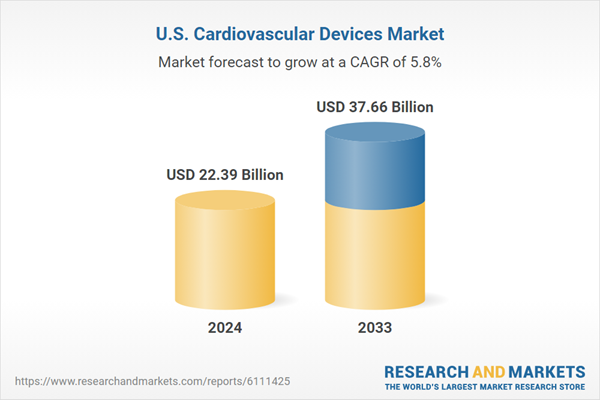U.S. Cardiovascular Devices Market Summary
The U.S. cardiovascular devices market size was estimated at USD 22.39 billion in 2024 and is projected to reach USD 37.66 billion by 2033, growing at a CAGR of 5.8% from 2025 to 2033. A cardiovascular device is a medical tool explicitly used to diagnose or treat diseases of the heart and blood vessels, including instruments like pacemakers, stents, artificial valves, defibrillators, angioplasty tools, and cardiac catheters.The rising incidence of cardiovascular diseases is one of the factors boosting market growth. According to the America Heart Association (AHA), in January 2024, there were 931,578 deaths in the U.S. attributed to cardiovascular disease, marking an increase of nearly 3,000 compared to the previous year. Additionally, the age-adjusted death rate from cardiovascular conditions rose to 233.3 per 100,000 individuals, reflecting a 4.0% increase from the prior year. This upward trend in mortality rates emphasizes the ongoing challenges posed by cardiovascular diseases, highlighting the critical need for innovative cardiovascular devices and interventions.
Moreover, as per the American Heart Association (AHA) article published in June 2024, cardiovascular disease (CVD) could affect over 184 million Americans, more than 61% of the population, by 2050. Alongside this expected rise in prevalence, CVD-related healthcare costs are expected to escalate dramatically, potentially reaching USD 1.8 trillion. This forecasted growth in cases and associated costs highlights an urgent need for advancements in cardiovascular devices. Therefore, the U.S. cardiovascular devices market is positioned for substantial growth as demand intensifies for innovative technologies that support early diagnosis, preventive care, and effective treatment solutions to manage the widespread impact of CVD on public health.
Increasing awareness campaigns and government-initiated screening programs for early detection of CVDs contribute to market expansion by ensuring more patients receive timely diagnosis and treatment. According to the American Heart Association, Inc. article published in November 2023, the 2023 guidelines from the American Heart Association (AHA), American College of Cardiology (ACC), American College of Chest Physicians (ACCP), and the Heart Rhythm Society (HRS) for the diagnosis & management of AFib stress the importance of raising awareness and implementing routine screening, especially in high-risk groups like older adults. These guidelines advocate for regular pulse and ECG screenings to ensure early detection and effective management of CVDs. For instance, early identification and treatment of AFib are crucial as they can significantly lower the risk of stroke and other serious complications.
The efficiency of targeted screening programs for CVDs fuels market growth. According to Springer Nature, in June 2024, a review of cardiology reports will examine the impact of screening programs. It highlights findings from multicenter studies, such as STROKESTOP and AF-SCREEN, which show that targeted screening greatly enhances the detection of CVDs, especially among older adults. The review strongly supports establishing national screening initiatives to address the growing burden of AFib-related complications, highlighting the critical role of early detection and intervention.
U.S. Cardiovascular Devices Market Report Segmentation
This report forecasts revenue growth at global, regional & country levels and provides an analysis of the industry trends in each of the sub-segments from 2021 to 2033. For this study, the analyst has segmented the U.S. cardiovascular devices market report based on product, and end-use:Product Outlook (Revenue, USD Million, 2021 - 2033)
- Diagnostic & Monitoring
- ECG
- Implantable Cardiac Monitors
- Holter Monitors
- Mobile Cardiac Telemetry
- MRI
- Cardiovascular Ultrasound
- Cardiac Diagnostic Catheters
- PET Scanner
- Surgical Devices
- Cardiac Resynchronization Therapy (CRT)
- Implantable Cardioverter Defibrillators (ICDs)
- Pacemakers
- Coronary Stents
- Catheters
- Guidewires
- Cannula
- Valves
- Occlusion Devices
End-use Outlook (Revenue, USD Million, 2021 - 2033)
- Hospitals
- Ambulatory Surgical Centers
- Diagnostic Centers
- Others
Why should you buy this report?
- Comprehensive Market Analysis: Gain detailed insights into the global market across major regions and segments.
- Competitive Landscape: Explore the market presence of key players worldwide.
- Future Trends: Discover the pivotal trends and drivers shaping the future of the global market.
- Actionable Recommendations: Utilize insights to uncover new revenue streams and guide strategic business decisions.
This report addresses:
- Market intelligence to enable effective decision-making
- Market estimates and forecasts from 2018 to 2030
- Growth opportunities and trend analyses
- Segment and regional revenue forecasts for market assessment
- Competition strategy and market share analysis
- Product innovation listing for you to stay ahead of the curve
- COVID-19's impact and how to sustain in these fast-evolving markets
This product will be delivered within 2 business days.
Table of Contents
Companies Mentioned
- Abbott
- GE HealthCare
- Edwards Lifesciences Corporation
- Siemens Healthineers AG
- Canon Medical Systems
- B. Braun SE
- LivaNova, Inc.
- Cardinal Health
- Medtronic
- Boston Scientific Corporation
- W. L. Gore & Associates, Inc.
- BIOTRONIK SE & Co. KG
Table Information
| Report Attribute | Details |
|---|---|
| No. of Pages | 90 |
| Published | June 2025 |
| Forecast Period | 2024 - 2033 |
| Estimated Market Value ( USD | $ 22.39 Billion |
| Forecasted Market Value ( USD | $ 37.66 Billion |
| Compound Annual Growth Rate | 5.8% |
| Regions Covered | United States |
| No. of Companies Mentioned | 12 |









